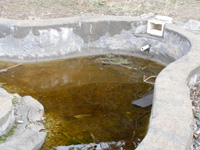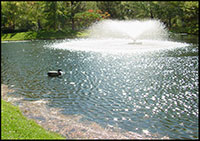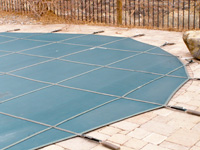Source Reduction
Source Reduction is a method in Vector Control that permanently reduces mosquito populations while eliminating pesticide use. Since mosquitos breed in standing water, Source Reduction can be as simple as homeowners emptying water from containers around the home. Mosquitos, like any insects, need water as part of their life cycle to reproduce. For example, a pond with weeds growing around the edge is where eggs are laid by an adult female mosquito. If vegetation is removed from the perimeter of the pond, it clears the deposition of eggs and the mosquito life's cycle in this body of water. Eliminating such mosquito breeding areas is extremely effective in the approach to Source Reduction.
Mosquitos capable of transmitting encephalitis viruses such as West Nile Virus are common in our area. Urban mosquito breeding in:
- catch basins
- detention and retention basins
- roadside ditches
- wetlands
- ponds, and
- utility vaults
are common in any municipality. Almost any water holding structure is capable of breeding mosquitos. Preventing mosquitos from reaching adulthood can be accomplished by Source Reduction, which minimizes disease risk and nuisances created by these insects. Homeowner associations, public entities and residents can manage their water features and infrastructure through good water management.
The Washoe County District Board of Health established regulations for the Vector-Borne Diseases Program to:
- Prevent the impact and severity of Vector-Borne Diseases;
- Improve waterways design in the community;
- Minimize the use of pesticides for poorly designed waterways; and
- Minimize insect and rodent issues.
These goals are met by:
- Using these design standards to decrease waterways ponding and nuisance water runoff;
- Assisting in the review and approval process by providing Community Development, planners and engineers waterways detail designs; and
- Providing and requiring these design standards in project development reviews.
Landscape Design
Landscape design with turf for common areas and typical front lots require an 18 inch catchment area from the back face of sidewalk reducing water runoff into catch basins. If only a curb exists without a sidewalk the catchment area is the same 18 inches. A wind sensor control unit is required which shuts off the irrigation system when the wind exceeds a set mph reducing excess water runoff.
Detention Basins & Retention Basins
Detention basins require a cobble line low flow channel between the inlet and outlet pipe allowing nuisance water runoff to flow through the facility while detaining storm water runoff in the winter. An infiltration trench 2 feet wide 3 feet deep constructed below the low flow channel will minimize water runoff through infiltration on site. For existing detention basins regrading between the inlet and outlet pipe will reestablish the flow line to eliminate water ponding in the basin.
Retention basin design requires the same cobble line low flow channel and infiltration trench constructed from the inlet to the farthest point in the basin since these basins have no outlet pipe.
All new channels require a low flow channel within the facility to allow water to flow through the drainage way.
Newly constructed swales are required to have the flow line lined with cobble rock.
Maintenance language is noted on building plans or placed in the CC&R's to maintain detention, retention basins and channels on an annual basis.
Access points are required for detention, retention basins and channels to allow access for inspection of these facilities.
Ponds
Newly constructed ponds, aeration is required with these units operating at a minimum of two hours in the morning and afternoon from April through October. The placement of cobble rock on the side slopes two feet above and below the mean water line is also required for these ponds.
In existing ponds aeration and the removal of vegetation around the perimeter is required.
Helicopter access is required for developments with new and existing channels, wetlands and large bodies of water for aerial treatments.
Catch Basins
New and existing private catch basins including basins in Washoe County infrastructure require a paver tray insert placed below the grate and above the outlet pipe. GPS points are required for new catch basins.
Wetland Design
A wetland design with low flow channels, sediment basins, ponds and native plants planted on the upland slopes for newly constructed wetlands.
Easy helicopter access is required for developments with new and existing channels, wetlands and large bodies of water for aerial treatments.
Erosion Prevention
Mechanical slope stabilization, fill the voids using a mixed aggregate of 3/4 inch D size to 1 1/2 inch to a depth of 4 inches to discourage void formation of rodent habitat.
For rockery walls, the voids in the face of the rockery wall filled for the entire height of the wall.
Backyard Mosquito SourcesAbandoned and unmaintained water features such as swimming pools, hot tubs, ponds, bird baths, and fountains are capable of producing mosquitos. Any structure that holds water is a potential mosquito habitat.

Small standing water sources around the home should be drained or cleaned regularly. Larger sources such as swimming pools, hot tubs, horse troughs and ornamental ponds require regular maintenance to prevent mosquito habitat development.

Swimming pools need a working filtration system to prevent mosquito habitat development. Components of a working filtration system include: filter, pump, chlorinator, return inlets, skimmer and main drain. Pools should be covered whenever possible. Only covers that completely block the water's surface will prevent mosquitos from colonizing an unmaintained water feature. Floating covers or tarps with gaps are not effective.

To report neglected water features or any other mosquito activity please contact the Vector-Borne Disease Prevention Program.
Neglected Water Feature Brochure
Mosquito Prevention for Ornamental Ponds
The Health District Vector-Borne Disease Prevention Program staff are finding mosquitos breeding in many ponds in the area. Our staff usually treat the ponds initially with one of several products that kill mosquito larvae. These products are effective for about one month in suppressing larval mosquitos. If conditions are right, the staff may also recommend planting the pond with mosquito fish (Gambusia affinis), which are avid consumers of mosquito larvae. Ponds which are not appropriate for mosquito fish require some other type of continued treatment to prevent breeding mosquitos.
Our staff request that homeowners take responsibility for continuing mosquito prevention in their own ponds. Homeowners can take several steps to reduce the possibility of breeding mosquitos. These include:
- Remove overhanging plants from the edge of the pond. These provide protection for breeding mosquitoes.
- Remove algae from the pond by raking or use of copper sulfate. Mosquito larvae thrive in algae.
- Line the edge of the pond with rock. This will inhibit plant growth.
- Install a small fountain or aerator. The movement of the water interferes with egg-laying by female mosquitos. An aerator will also suppress mosquitos by improving general water quality.
- Try using mosquito donuts for larval control. This is a product similar to one used by our staff for larval abatement. The donuts may be bought at hardware, nursery, and ornamental pond stores in the area.
Our staff are available to answer questions and provide consulting to assist you in finding long-term solutions to prevent mosquitos from breeding in your ornamental or stock pond.
Last modified on 08/15/2023
Let’s Stay in Touch
Sign up for our newsletter
